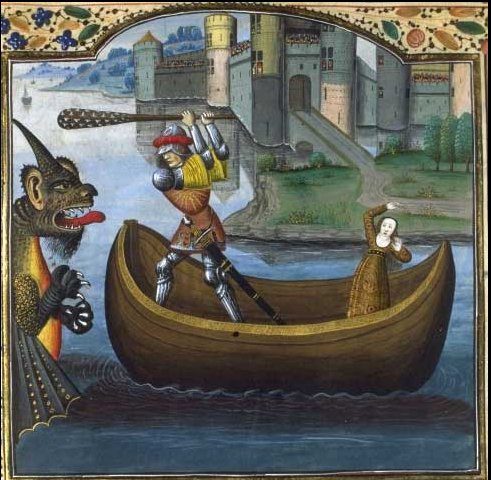The nature of the weapon for killing the Sea Beast which had Andromeda in his power could vary: "On condition that, if he rescued her, she should be his wife and return to Greece with him, Perseus took to the air again, grasped his sickle and, diving murderously from above, beheaded the approaching monster, which was deceived by his shadow on the sea. He had drawn the Gorgon's head from the wallet, lest the Monster might look up, and now laid it face downwards on a bed of leaves and sea-weed (which immediately turned to coral), while he cleansed his hands of blood, raised three altars and sacrificed a calf, a cow, and a bull to Hermes, Athene, and Zeus respectively." (The Greek Myths) In Polynesia it could have been a wooden spear. What mattered most was not how but when: "Heracles's rescue of Hesione, parallelled by Perseus's rescue of Andromeda ... is clearly derived from an icon common in Syria and Asia Minor: Marduk's conquest of the Sea-monster Tiamat, an emanation of the goddess Ishtar, whose power he annulled by chaining her to a rock. Heracles is swallowed by Tiamat, and disappears for three days before fighting his way out. So also, according to a Hebrew moral tale apparently based on the same icon, Jonah spent three days in the Whale's belly; and so Marduk's representative, the king of Babylon, spent a period in demise every year, during which he was supposedly fighting Tiamat ... Marduk's or Perseus's white solar horse here becomes the reward for Hesione's rescue. Heracles's loss of hair emphasizes his solar character: a shearing of the sacred king's locks when the year came to an end, typified the reduction of his magical strength, as in the story of Samson ... When he reappeared, he had no more hair than an infant." (The Greek Myths) We have earlier found March 29 (as in 329 for the day when the Sun and Antares rose together) to be the final of the back side text and the mauga ('last') glyph in *Ca14-11 agrees. It has the 'Janus feature' - mata in both directions:
However, according to the Arabs 'time zero' did not arrive immediately after March 29 (with heliacal Delta Andromedae) but 3 days later, where the left arm of Andromeda via her star η joined the back of the rising northern of the pair of Pisces fishes:
Possibly there were 3 days necessary for the transformation from the cold winter solstice to the 'thawing', necessary for the Sun to 'fight his way out':
... A very detailed myth comes from the island of Nauru. In the beginning there was nothing but the sea, and above soared the Old-Spider. One day the Old-Spider found a giant clam, took it up, and tried to find if this object had any opening, but could find none. She tapped on it, and as it sounded hollow, she decided it was empty. By repeating a charm, she opened the two shells and slipped inside. She could see nothing, because the sun and the moon did not then exist; and then, she could not stand up because there was not enough room in the shellfish. Constantly hunting about she at last found a snail. To endow it with power she placed it under her arm, lay down and slept for three days. Then she let it free, and still hunting about she found another snail bigger than the first one, and treated it in the same way ... I guess the Greek letter eta was used here in order to signify 'inside':
Achird is η Cassiopeiae, and possibly the last letter in Achird was added in order to indicate a female: ... Allen does not mention Achird and he has no other name for η Cassiopejae, but I guess the star could be connected with α Leonis, Regulus, once named Achir (Possessing Luminous Rays): 'Naturally sharing the character of its constellation as the Domicilium Solia, in Euphratean astronomy it was Gus-ba-ra, the Flame, or the Red Fire, of the House of the East; in Khorasmia, Achir, Possessing Luminous Rays; and throughout classical days the supposed cause of the summer's heat, a reputation that it shared with the Dog-star.' Saturn (378) may have been necessary to make the 'Red Fire' reemerge. Sunday comes after Saturnday.
378 = 14 * 27 = 54 weeks. The horizontally drawn out shape of the sitting figure in *Ca14-17 could allude to the 'long pit' of the winter solstice: ... The Maori used the same word for both solstices, marua-roa, 'long pit', and applied the term also to the month or season during which the Sun passed through its most northerly or southerly declination. A qualifying word such as takurua, 'winter', or o-rongo-nui, 'summer', was usually appended to denote which solstice was meant. When no explanatory word was added marua-roa seems to have signified the winter solstice ...
| ||||||||||||||||||||||||||||||||||||||||||||||||||||||||||||||||||||||||||||||||||||||||||||||||||||||||||||||||||||||||||||||||||||||||||||||||



